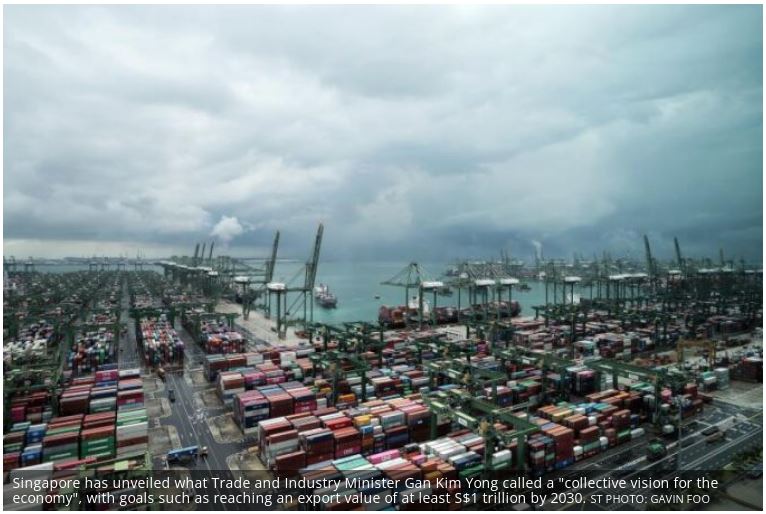Singapore unveils 10-year economic strategy with new targets for trade and other pillars
SINGAPORE has unveiled what Trade and Industry Minister Gan Kim Yong called a “collective vision for the economy”, with goals such as reaching an export value of at least S$1 trillion by 2030.
The Singapore Economy 2030 vision for services, manufacturing, trade and enterprises “will put our industries, enterprises, and workers on a firmer footing for long-term, sustainable growth” over the next decade, Gan told the House on Friday (Mar 4).
For instance, the Ministry of Trade and Industry (MTI) intends to raise Singapore’s export value from S$805 billion in 2020 to at least S$1 trillion by 2030, and double offshore trade value to US$2 trillion as well.
The Republic also wants to capture more re-exports and transshipment flows, and to expand trade with more economies with deeper connections in global supply chains.
“Given our small domestic market, global connectivity is essential to help our enterprises grow beyond our borders,” Gan said of the strategy’s trade ambitions.
Besides redoubling efforts to develop innovative local traders with global scale, the MTI is working with partners to build talent who can trade carbon credits and other commodities, and also plans to attract leading global traders that will anchor more of their activities here.
Meanwhile, the master plan lays out new initiatives under Singapore’s Manufacturing 2030 strategy announced in 2021, which aims to grow manufacturing value-add by 50 per cent.
Support measures will include “bespoke support for manufacturers with strong potential, to deepen their capabilities and expand their global reach”, Gan said.
The MTI will also help to develop human capital for the manufacturing sector through a M2030 Careers Initiative to train polytechnic and Institute of Technical Education (ITE) graduates.
The initiative will offer at least 200 internships for ITE students from 60 companies by end-2022, as well as a pilot grant to hire ITE graduates for critical technician and assistant engineer roles.
That’s as the manufacturing sector most recently grew by 13.2 per cent in 2021, while drawing S$8.5 billion in fixed asset investments, which are projected to create more than 6,000 jobs.
On the services front, Gan highlighted opportunities in sustainability and digitalisation. He also pointed to the need to support local businesses in “a vibrant ecosystem of Singapore enterprises that are future-ready, globally competitive, and possess deep innovative capabilities”.
Local enterprises form the fourth and final pillar of the Singapore Economy 2030 vision, with Second Minister for Trade and Industry Tan See Leng to elaborate on the government’s plans to support such local firms, said Gan.
Overall, he noted headwinds such as geopolitical tensions and rising protectionism, but added that “there are also many exciting developments in key sectors across our economy”.
“To position ourselves for growth and seize these opportunities, we must continue to invest in our fundamentals, and build up strong capabilities in our enterprises and our people,” he said.
Source: https://www.businesstimes.com.sg/government-economy/singapore-unveils-10-year-economic-strategy-with-new-targets-for-trade-and-other


 Thailand
Thailand




